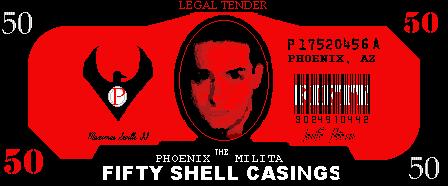Difference between revisions of "Shell Casing"
m |
|||
| (3 intermediate revisions by 2 users not shown) | |||
| Line 1: | Line 1: | ||
| + | {{CurrencyBox | | ||
| + | symbol=$C | | ||
| + | nation= All Nations in the [[Johnified States of America]] region | | ||
| + | date=June 2003 | | ||
| + | iso= SC | | ||
| + | value= 1 $C = 1 USD(Universal Standard Dollar) | | ||
| + | }} | ||
The Shell Casing was devised by the nation of [[The Phoenix Milita]] Originaly it consisted of brass shells, engraved with TPM's motto and plated with 24 karat gold, silver or copper. | The Shell Casing was devised by the nation of [[The Phoenix Milita]] Originaly it consisted of brass shells, engraved with TPM's motto and plated with 24 karat gold, silver or copper. | ||
However as more nations adopted, or were forced to adopt the currency as it became the standard currency for those living in (the now dead) region of "American Alliance", the system of using actual shell casings was found to be more and more cumbersome. | However as more nations adopted, or were forced to adopt the currency as it became the standard currency for those living in (the now dead) region of "American Alliance", the system of using actual shell casings was found to be more and more cumbersome. | ||
| − | The system was abolished and a new paper currency was created. The new shell casings were printed in the same amounts as the old shells were produced in plus 4 larger notes (100,500 and 1000) making the | + | The system was abolished and a new paper currency was created. The new shell casings were printed in the same amounts as the old shells were produced in plus 4 larger notes (100,500 and 1000) making the transition easier. Each dollar value has a different tint to the paper (4 shades of blue, 5 shades of red, 2 shades of green, some others) to avoid counterfeiting and all notes have microprinting, polyester strip as well as special color-shift ink |
| − | On a side note the practice of carrying hip-pouches, clips or magazines filled with shell | + | On a side note the practice of carrying hip-pouches, clips or magazines filled with shell casings went out of style as wallets and purses were re-introduced to society. Smaller caliber rounds are still used today in place of coins, and it has become acceptable to clip off the walls of the case, leaving only the inscribed primer area. Vending machines were modified to accept the new "sawed off" shell casings in 2007 |
| − | * | + | *[[Image:ShellCasing50SC.gif]] |
| − | + | :The $50 paper note, worth 50 Shell casings, 2007 series featuring Field Marshall [[Maximus Seville II]]'s portrait | |
*http://img.photobucket.com/albums/v293/grunt74/NS1/c.jpg | *http://img.photobucket.com/albums/v293/grunt74/NS1/c.jpg | ||
| − | + | :A collection of gold .50 shells (.50 caliber), which were each worth 50 shell casings. | |
| − | [[ | + | *[[Image:TPMMoney.jpg]] |
| + | :By 2044, [[The Phoenix Milita]] became [[The Phoenix Militia]] had switched to a single black and red color scheme for all denominations and a composite fiber, polymer reinforced note. | ||
| + | |||
| + | {{currencies}}[[Category:The Phoenix Milita]] | ||
Latest revision as of 18:49, 15 February 2007
| Shell Casing | ||||||||
|---|---|---|---|---|---|---|---|---|
| $C | ||||||||
|
The Shell Casing was devised by the nation of The Phoenix Milita Originaly it consisted of brass shells, engraved with TPM's motto and plated with 24 karat gold, silver or copper.
However as more nations adopted, or were forced to adopt the currency as it became the standard currency for those living in (the now dead) region of "American Alliance", the system of using actual shell casings was found to be more and more cumbersome.
The system was abolished and a new paper currency was created. The new shell casings were printed in the same amounts as the old shells were produced in plus 4 larger notes (100,500 and 1000) making the transition easier. Each dollar value has a different tint to the paper (4 shades of blue, 5 shades of red, 2 shades of green, some others) to avoid counterfeiting and all notes have microprinting, polyester strip as well as special color-shift ink
On a side note the practice of carrying hip-pouches, clips or magazines filled with shell casings went out of style as wallets and purses were re-introduced to society. Smaller caliber rounds are still used today in place of coins, and it has become acceptable to clip off the walls of the case, leaving only the inscribed primer area. Vending machines were modified to accept the new "sawed off" shell casings in 2007
- The $50 paper note, worth 50 Shell casings, 2007 series featuring Field Marshall Maximus Seville II's portrait
- A collection of gold .50 shells (.50 caliber), which were each worth 50 shell casings.
- By 2044, The Phoenix Milita became The Phoenix Militia had switched to a single black and red color scheme for all denominations and a composite fiber, polymer reinforced note.



